by Beatrice Ricci
City Space Architecture
On Thursday 20th April 2023 the exhibition Imagining Public Space with/for Her, curated by Carolina Anderson, Beatrice Ricci and Luisa Bravo, opened at Museo Spazio Pubblico in Bologna, the artistic headquarters of the cultural association City Space Architecture.
Presented in the framework of international initiatives developed by City Space Architecture – whose focus is to promote public space culture, through art and architecture, in order to build more inclusive and sustainable cities – the exhibition is willing to activate a crucial debate about public space analysed from a gender perspective, giving (ideal and physical) space to world-wide projects that stress the urgency of re-thinking the city and its public spaces with and for women. It is intended to open a specific discussion that it is strongly intertwined with the broader and certainly most debated challenge of accessibility and inclusiveness of public spaces. The radical question is: who does public space really belong to? who is public space designed for?
One of the main problems of cities is that they are often designed by and for a single subject: man. Women have rarely been taken into consideration as active subjects in the design and use of the city and its public spaces. The first theories linking architecture and the feminist struggle date back to the 1970s, but it was only between the 1980s and 1990s that a gender perspective was applied to urban planning for the first time. The most famous case, which has been a reference for several decades, is that of Vienna, thanks to the work of Eva Kail. Her first step in making women’s problems related to public space visible was an exhibition held in 1991 entitled “Who does public space belong to – women’s everyday life in the city“. This led to the establishment, in 1998, of an office responsible for ensuring gender equality in urban planning.
More than 30 years later the exhibition Imagining Public Space with/for Her makes clear how it is still necessary and urgent to talk about public space attentive to the needs of women. For this purpose the exhibition is conceived not as a canonical display of contents, but as a way to collect materials through a process of co-creation, giving visibility to several leading professional figures who are dealing with this issue, selected and invited by City Space Architecture.
The exhibition takes place in two different venues: in the indoor space of Museo Spazio Pubblico and in the outdoor space of the adjacent public garden, named as Il Giardino, that City Space Architecture is managing after signing a cooperation agreement with the Municipality of Bologna, in the framework of the Regulation on collaboration between citizens and the city for the care and regeneration of urban commons.
At Museo Spazio Pubblico are displayed, in the form of explanatory panels, nine main projects:
– (Italy) Florencia Andreola and Azzurra Muzzonigro, Sex and the City, highlting their Milan Gender Atlas
– (Egypt) Nourhan Bassam, GamingX
– (United Kingdom) Anna Barker, Safer Park Project
– (Cyprus) Teresa Tourvas, Frau Architekt
– (Belgium) Rozina Spinnoy, Empowering Women, Public space and Climate Change
– (Kenya) Elin Fabre and Tove Levonen, HER CITY, UN-Habitat
– (Argentina) Annabella Roitman, Urbanismo Feminista
– (Spain) Roser Casanova, Adriana Ciocoletto, Marta Fonseca Salinas, Sara Ortiz Escalante, Blanca Valdivia Gutiérrez, Karina Díaz Abanto, Karina Díaz Abanto, Magda Isart Bosch, Ainara Navarrete, Collectiu.6
– (United Kingdom) Sara Candiracci, Cities Alive: Designing cities that work for women
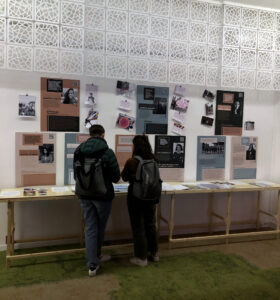
These are research projects, case studies on cities, exhibitions, reports and educational activities that highlight how ensuring the equal participation of women in the design and use of public space is essential to build more accessible and inclusive cities for all. The materials relating to each project can be consulted in the exhibition (in the case of publications) but also downloaded via QRcode. The idea is that this wall can stimulate further research and reading for local visitors.
The side wall hosts the photographic project “Pour se tailler une place” by Michelle Caron-Pawlowsky that is part of the ADOES project (2018-2022), led by researchers Nathalie Boucher and Sarah-Maude Cossette from REsPIRE, a non-profit based in Montreal (Canada) that does qualitative research on urban issues, such as users perceptions and experiences of public spaces. The photo series presents teenage girls aged 14 to 20, met in public spaces of Montreal’s Pointe-aux-Trembles neighborhood in the summer of 2022 during the production of the short film ADOES. The point of view of teenager girls in public spaces greatly enriches the discussion, too often focused on the “macro-category” of adult women. The project is completed by a video, ADOES, which collects interviews to teen girls and their use of public space in Montreal. This video was also shortlisted for the 2022 edition of the Urban Visions Film Festival, promoted by City Space Architecture.
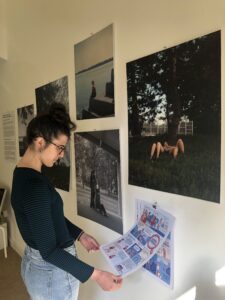 “We captured the girls as they were, where they were: sitting and talking on a picnic table or a swing, enjoying the outdoors lying on the grass or by the river, or skateboarding under a park shelter. Our research confirms that girls like to get together with friends and talk, ideally in a secluded, quiet place, using equipment that allows them to sit in small groups, protected from the weather. But urban planning, focused on so-called active practices, has little to offerto teenage girls: a few neglected tables and benches, on the margins of sports fields, constitute too rare opportunities for them. In an environment that disfavors sociability practices – considered superficial, not active enough, and thus unhealthy, especially among youth/girls – adolescent girls use their experience and skills to find and take their place, such as using the parks’ equipment wisely when no other users are around.”
“We captured the girls as they were, where they were: sitting and talking on a picnic table or a swing, enjoying the outdoors lying on the grass or by the river, or skateboarding under a park shelter. Our research confirms that girls like to get together with friends and talk, ideally in a secluded, quiet place, using equipment that allows them to sit in small groups, protected from the weather. But urban planning, focused on so-called active practices, has little to offerto teenage girls: a few neglected tables and benches, on the margins of sports fields, constitute too rare opportunities for them. In an environment that disfavors sociability practices – considered superficial, not active enough, and thus unhealthy, especially among youth/girls – adolescent girls use their experience and skills to find and take their place, such as using the parks’ equipment wisely when no other users are around.”
Another very interesting aspect of this exhibition is the fact that it is conceived to be an opportunity to collect materials in an open and constantly growing process. For this reason it includes a dedicated section intended as a large notebook collecting individual reflections and highlights on specific projects, that are collected by the curators throughout the duration of the exhibition. This co-creation process makes visible the enormous attention that exists around public space from a gender perspective.
This section currently presents the work of:
– (New Zealand) Boopsie Maran, a collection of pictures of women appropriating public spaces in Auckland and New Zealand
– (Australia) Claire Edwards, a collection of pictures from Sydney (Dancers at Moriarty Walk) and Manchester (Cathedral Gardens) showing use and performances of women in public space
– (Portugal-Mexico) Antonio Lara Hernandez and Abraham Echazarreta, presenting the research “Between lockdown and regeneration: Temporary appropriation, informality and displacement. The case of Merida, Yucatan”. The research enquires on the role that long-term regeneration policies to market the Heritage City Centre have had on the displacement of TA practices; and the effect that emergency measures have had on the accentuation of these patterns. Intended as multi-disciplinary research, utilising an assemblage and resilient thinking approach, it selects Merida City Centre (Mexico) as a case study. Such context experienced a severe lockdown in parallel with a full over whole re-structuration of the urban mobility system, including a significant renovation of the streetscape design
– (Italy) Lamia A Abdelfattah – Compartmentalized
– (Spain) Ricardo Klein, a collection of pictures depicting gigantic murals with faces of women in different cities.
– (Australia) Safer Cities Program from Transport for New South Wales (NSW), a two-year program aimed to understand and trial place-based approaches to improve safety for people who identify as women and girls, when walking to, through and within public spaces. The program incorporates research and engagement with government and the community to test and deliver works to:
• Increase women and girls’ safety and access to public spaces
• Increase women and girls’ active and meaningful participation in urban development and governance
• Increase women and girls’ autonomous mobility in the city.
Parramatta Park in Western Sydney is one public place where, as part of the Safer Cities program, safety improvements will be made to help women and girls feel safer, especially at night.
The exhbition in the outdoor space of the adjacent public garden, named as Il Giardino, is animated by a series of posters in the form of definitions and quotations, presented as strong statements (in Italian) to local residents and users. This way passers-by are asked to be curious and reflect on those statements, while entering and “inhabiting” the garden.
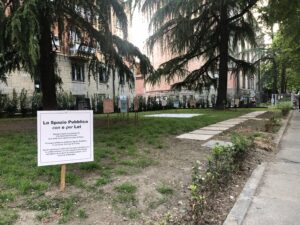
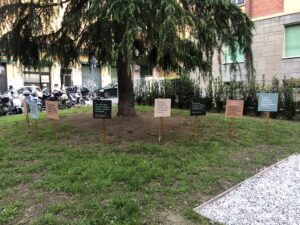
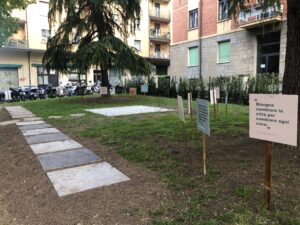
The exhibition will be complemented through a series of online interviews with some of the female figures whose work is on display at Museo Spazio Pubblico, that will be live streamed on City Space Architecture Youtube channel and social media. The discussion is open to collect additional contributions through the on-going online survey “Is public space made with/for her? “.
Finally, a box placed inside Museo Spazio Pubblico aims to collect further opinions from the local public visiting the exhibition, bringing their voice into the dialogue.
The exhibition is open to the public with free entrance from 21th April till 28th May 2023, by appointment only. Two special events will take place on 16th May and 29th May at Museo Spazio Pubblico and at Il Giardino with the curators.
For more info, send an email to: info@museospaziopubblico.it.
Museo Spazio Pubblico, via Eugenio Curiel 13/d, Bologna, Italy.
Acknowledgment
The exhibition is part of the European project A-Place. Linking places through networked artistic practices, and co-funded by the Creative Europe program of the European Union, included in the action “A Resilient Place” promoted by City Space Architecture.

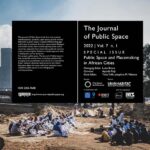
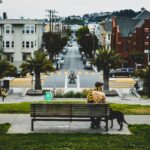
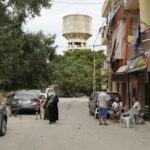
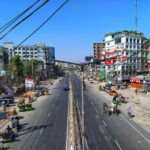
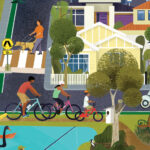
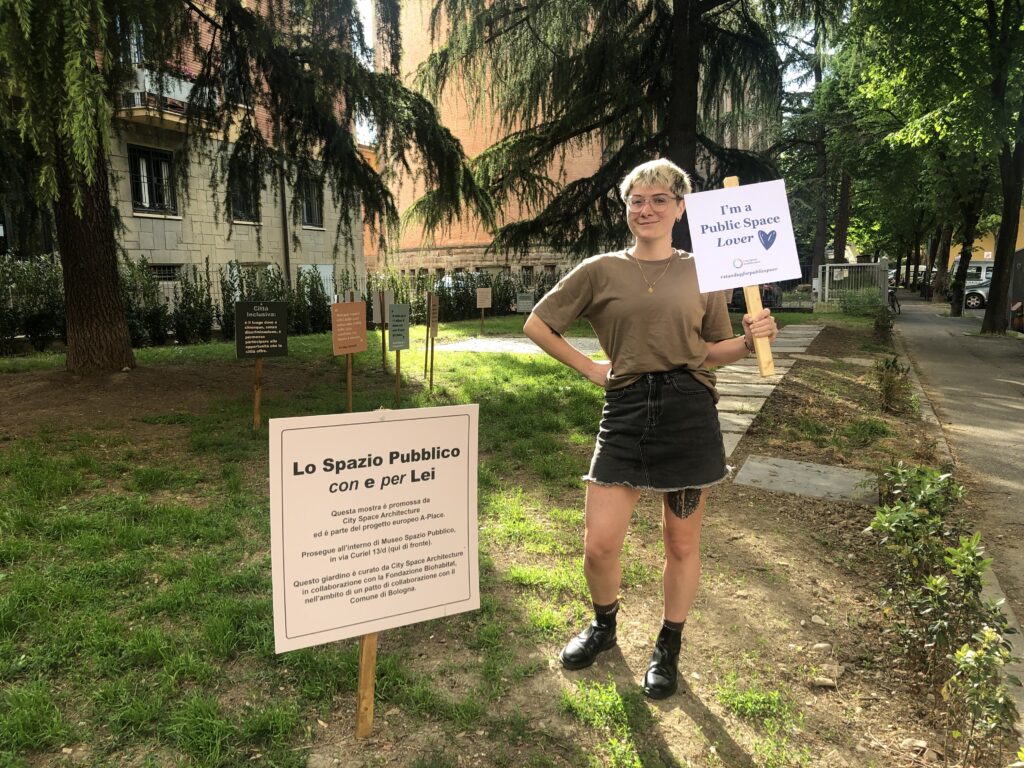
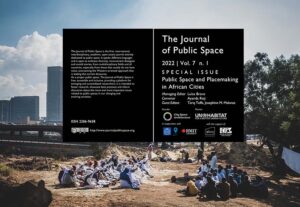
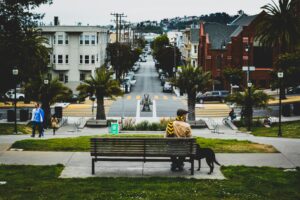
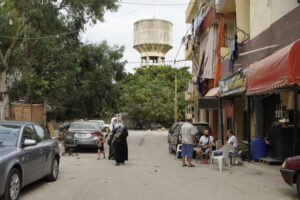
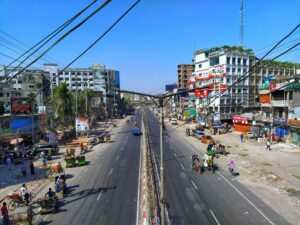
More Stories
Defining Placemaking: What Does It Really Mean?
A Space of Our Own
Public Space Award in NYC by Open Plans